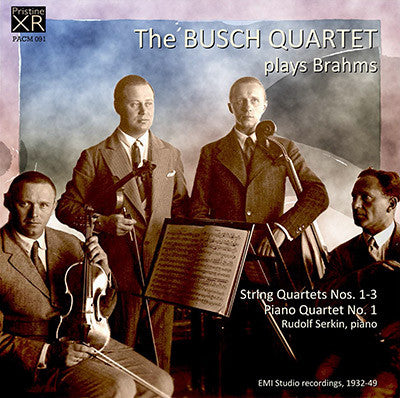
This album is included in the following sets:
This set contains the following albums:
- Producer's Note
- Full Track Listing
- Cover Art
Pioneering Busch String Quartet brilliant with Brahms
"The Busch Quartet are at the top of their form ... exceedingly good" - The Gramophone
These recordings provide us with a wonderful sweep of time both in terms of chamber music performance in the era of commercial sound recording, and in terms of recording quality. Thanks in part to the efforts of the National Gramophonic Society, by 1932 the major record companies were taking chamber music seriously and the Busch Quartet were among the vanguard of a handful of new, highly professional, technically brilliant groups able to profit from this.
By the time they returned to the Brahms Quartets another revolution was in the air, and we hear clearly the quality leap from the 78rpm disc recordings of the 2nd Quartet to the taped recordings of the 3rd and the Piano Quartet.
All the recordings have benefited enormously from both pitch correction and/or stabilisation and XR remastering in these new transfers.
Andrew Rose
BRAHMS String Quartet No. 1 in C minor, Op. 51, No. 1
Recorded 19 & 23 September, 1932
Issued as HMV DB 1807-10
Matrix Nos. 2B.3858-65
BRAHMS String Quartet No. 2 in A minor, Op. 51, No. 2
Recorded 19 April, 1947
Issued as Columbia LX.1022-25
Matrix Nos. CAX.9871-78
BRAHMS String Quartet No. 3 in B flat major, Op. 57
Recorded 17 & 21 May, 1949
Issued as Columbia LX.1262-5 & LXS.1266
Matrix Nos. CAX.10511-19
BRAHMS Piano Quartet No. 1 in G minor, Op. 25
Recorded 25 & 26 May, 1949
Issued as Columbia LX.1217-21
Matrix Nos. CAX.10520-29
Rudolf Serkin piano
Adolf Busch violin
Gösta Andreasson(1)/Ernest Drucker(2)/Bruno Straumann(3) violin
Karl Doktor(1)/Hugo Gottesmann(2-4) viola
Hermann Busch cello
Gramophone Historic Review
Let me say at once : this is a wonderful performance indeed
A.R., The Gramophone Review of String Quartet No. 2, November 1947
Let me say at once : this is a wonderful performance indeed. The four players are not perhaps in their very highest form in the first movement, but that still leaves them well ahead of most other quartets I have heard. Serkin’s opening phrase is not well calculated and he shows elsewhere in the movement some tendency to push on in a rather ruthless way with heaviness of accentuation : but you can scarcely be in doubt that you are in for a big performance. In the Intermezzo all the players have found their form and this odd but magical movement gets a really lovely performance.
But the heights—and the highest heights— are reached in a magnificent reading of the slow movement. The intensity of feeling in the opening section is a quality characteristic of the Busch players (and notably, of course, of their leader) : equally noteworthy is the playing in the contrasting С major section that follows. Indeed, the performance of this whole movement makes it quite clear that we are listening to artists of the very highest calibre.
And having arrived at this form they proceed to a performance of Brahms’ wonderful Finale, which is by turns scintillating and wonderfully alluring. How well, for one thing, those changes of time and rhythm are judged. Thé balance of the instruments in the recording is excellent throughout, the ensemble is impeccable, while the quality of recorded sound is very good (though, like the. playing, it seemed to me to improve from good to excellent as it went along). This is a magnificent set of records.
T.H., The Gramophone Review of Piano Quartet No. 1, September 1949

